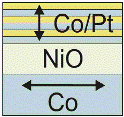Department of Physics and Astronomy: Publications and Other Research

Shireen Adenwalla Papers
Document Type
Article
Date of this Version
8-2011
Citation
Published in Journal of Physics: Condensed Matter, vol. 23, no. 37 (2011), 6 pp. doi:10.1088/0953-8984/23/37/376002
Abstract
We investigate the competing effects of interlayer exchange coupling and magnetostatic coupling in the magnetic heterostructure ([Co/Pt]/NiO/[Co/Pt]) with perpendicular magnetic anisotropy (PMA). This particular heterostructure is unique among coupled materials with PMA in directly exhibiting both ferromagnetic and antiferromagnetic coupling, oscillating between the two as a function of spacer layer thickness. By systematically tuning the coupling interactions via a wedge-shaped NiO spacer layer, we explore the energetics that dictate magnetic domain formation using high resolution magnetic force microscopy coupled with the magneto-optical Kerr effect. This technique probes the microscopic and macroscopic magnetic behavior as a continuous function of thickness and the interlayer exchange coupling, including the regions where interlayer coupling goes through zero. We see significant changes in domain structure based on the sign of coupling, and also show that magnetic domain size is directly related to the magnitude of the interlayer exchange coupling energy, which generally dominates over the magnetostatic interactions. When magnetostatic interactions become comparable to the interlayer exchange coupling, a delicate interplay between the differing energy contributions is apparent and energy scales are extracted. The results are of intense interest to the magnetic recording industry and also illustrate a relatively new avenue of undiscovered physics, primarily dealing with the delicate balance of energies in the formation of magnetic domains for coupled systems with PMA, defining limits on domain size as well as the interplay between roughness, domains and magnetic coupling.
Included in
Condensed Matter Physics Commons, Engineering Physics Commons, Materials Science and Engineering Commons, Nanoscience and Nanotechnology Commons


Comments
Copyright © 2011 IOP Publishing Ltd. Used by permission.